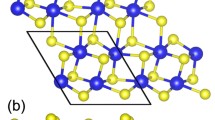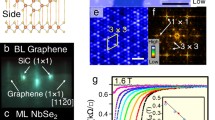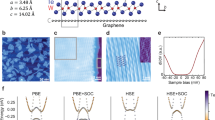Abstract
During the development of ultrathin two-dimensional (2D) materials, the appearance of ripples has been widely observed. However, the formation mechanisms and their influences are still rarely investigated, especially their contributions to the electronic structures and optical properties. To compensate for the knowledge gap, we have carried out comprehensive theoretical studies on the monolayer WSe2 with a series of ripple structures from 0 to 12 Å in different lattice sizes. The sensitivity of the formation energy, band structures, electronic structures, and optical properties to the ripple structures have been performed systematically for the first time. The formation of ripples in Armchair and Zigzag simultaneously are more energetically favorable, leading to more flexible optimizations of the optoelectronic properties. The improved charge-locking effect and extension of absorption ranges indicate the significant role of ripple structures. The spontaneous formation of ripples is associated with orbital rearrangements and structural distortions. This leads to the unique charge carrier correlate inversion between W-5d and Se-4p orbitals, resulting in the pinning of the Fermi level. This work has supplied significant references to understand ultrathin 2D structures and benefit their future developments and applications in high-performance optoelectronic devices.

Similar content being viewed by others
References
Manzeli, S.; Ovchinnikov, D.; Pasquier, D.; Yazyev, O. V.; Kis, A. 2D transition metal dichalcogenides. Nat. Rev. Mater. 2017, 2, 17033.
Wang, Q. H.; Kalantar-Zadeh, K.; Kis, A.; Coleman, J. N.; Strano, M. S. Electronics and optoelectronics of two-dimensional transition metal dichalcogenides. Nat. Nanotechnol. 2012, 7, 699–712.
Mak, K. F.; Shan, J. Photonics and optoelectronics of 2D semiconductor transition metal dichalcogenides. Nat. Photon. 2016, 10, 216–226.
Chowdhury, T.; Sadler, E. C.; Kempa, T. J. Progress and prospects in transition-metal dichalcogenide research beyond 2D. Chem. Rev. 2020, 120, 12563–12591.
Zheng, H. H.; Wu, B.; Wang, C. T.; Li, S. F.; He, J.; Liu, Z. W.; Wang, J. T.; Duan, J. A.; Liu, Y. P. Exploring the regulatory effect of stacked layers on Moiré excitons in twisted WSe2/WSe2/WSe2 homotrilayer. Nano Res in press, https://doi.org/10.1007/sl2274-023-5822-8.
Zhao, B.; Dang, W. Q.; Yang, X. D.; Li, J.; Bao, H. H.; Wang, K.; Luo, J.; Zhang, Z. W.; Li, B.; Xie, H. P. et al. Van der Waals epitaxial growth of ultrathin metallic NiSe nanosheets on WSe2 as high performance contacts for WSe2 transistors. Nano Res. 2019, 12, 1683–1689.
Rasmita, A.; Gao, W. B. Opto-valleytronics in the 2D van der Waals heterostructure. Nano Res. 2021, 14, 1901–1911.
Miró, P.; Ghorbani-Asl, M.; Heine, T. Spontaneous ripple formation in MoS2 monolayers: Electronic structure and transport effects. Adv. Mater. 2013, 25, 5473–5475.
Tapasztó, L.; Dumitrică, T.; Kim, S. J.; Nemes-Incze, P.; Hwang, C.; Biró, L. P. Breakdown of continuum mechanics for nanometre-wavelength rippling of graphene. Nat. Phys. 2012, 8, 739–742.
Brivio, J.; Alexander, D. T. L.; Kis, A. Ripples and layers in ultrathin MoS2 membranes. Nano Lett. 2011, 11, 5148–5153.
Li, X. S.; Cai, W. W.; An, J.; Kim, S.; Nah, J.; Yang, D. X.; Piner, R.; Velamakanni, A.; Jung, I.; Tutuc, E. et al. Large-area synthesis of high-quality and uniform graphene films on copper foils. Science 2009, 324, 1312–1314.
Zhang, W. J.; Huang, J. K.; Chen, C. H.; Chang, Y. H.; Cheng, Y. J.; Li, L. J. High-gain phototransistors based on a CVD MoS2 monolayer. Adv. Mater. 2013, 25, 3456–3461.
Tongay, S.; Fan, W.; Kang, J.; Park, J.; Koldemir, U.; Suh, J.; Narang, D. S.; Liu, K.; Ji, J.; Li, J. B. et al. Tuning interlayer coupling in large-area heterostructures with CVD-grown MoS2 and WS2 monolayers. Nano Lett. 2014, 14, 3185–3190.
Pochet, P.; McGuigan, B. C.; Coraux, J.; Johnson, H. T. Toward Moiré engineering in 2D materials via dislocation theory. Appl. Mater. Today 2017, 9, 240–250.
Ahn, G. H.; Amani, M.; Rasool, H.; Lien, D. H.; Mastandrea, J. P.; Ager III, J. W.; Dubey, M.; Chrzan, D. C.; Minor, A. M.; Javey, A. Strain-engineered growth of two-dimensional materials. Nat. Commun. 2017, 8, 608.
Deng, S. K.; Berry, V. Wrinkled, rippled and crumpled graphene: An overview of formation mechanism, electronic properties, and applications. Mater. Today 2016, 19, 197–212.
Xie, S. E.; Tu, L. J.; Han, Y. M.; Huang, L. J.; Kang, K.; Lao, K. U.; Poddar, P.; Park, C.; Muller, D. A.; DiStasio, R. A. Jr. et al. Coherent, atomically thin transition-metal dichalcogenide superlattices with engineered strain. Science 2018, 359, 1131–1136.
Hendricks, T. R.; Wang, W.; Lee, I. Buckling in nanomechanical films. Soft Matter 2010, 6, 3701–3706.
Ostadhossein, A.; Rahnamoun, A.; Wang, Y. X.; Zhao, P.; Zhang, S. L.; Crespi, V. H.; van Duin, A. C. T. ReaxFF reactive force-field study of molybdenum disulfide (MoS2). J. Phys. Chem. Lett. 2017, 8, 631–640.
Wang, Y. X.; Crespi, V. H. NanoVelcro: Theory of guided folding in atomically thin sheets with regions of complementary doping. Nano Lett. 2017, 17, 6708–6714.
Petrović, M.; Sadowski, J. T.; Šiber, A.; Kralj, M. Wrinkles of graphene on Ir(111): Macroscopic network ordering and internal multi-lobed structure. Carbon 2015, 94, 856–863.
Jung, S.; Rutter, G. M.; Klimov, N. N.; Newell, D. B.; Calizo, I.; Hight-Walker, A. R.; Zhitenev, N. B.; Stroscio, J. A. Evolution of microscopic localization in graphene in a magnetic field from scattering resonances to quantum dots. Nat. Phys. 2011, 7, 245–251.
Zang, J. F.; Ryu, S.; Pugno, N.; Wang, Q. M.; Tu, Q.; Buehler, M. J.; Zhao, X. H. Multifunctionality and control of the crumpling and unfolding of large-area graphene. Nat. Mater. 2013, 12, 321–325.
Zhu, Y. W.; Murali, S.; Stoller, M. D.; Ganesh, K. J.; Cai, W. W.; Ferreira, P. J.; Pirkle, A.; Wallace, R. M.; Cychosz, K. A.; Thommes, M. et al. Carbon-based supercapacitors produced by activation of graphene. Science 2011, 332, 1537–1541.
Stankovich, S.; Dikin, D. A.; Dommett, G. H. B.; Kohlhaas, K. M.; Zimney, E. J.; Stach, E. A.; Piner, R. D.; Nguyen, S. T.; Ruoff, R. S. Graphene-based composite materials. Nature 2006, 442, 282–286.
Deng, S. K.; Gao, E. L.; Wang, Y. L.; Sen, S.; Sreenivasan, S. T.; Behura, S.; Král, P.; Xu, Z. P.; Berry, V. Confined, oriented, and electrically anisotropic graphene wrinkles on bacteria. ACS Nano 2016, 10, 8403–8412.
Ramanathan, T.; Abdala, A. A.; Stankovich, S.; Dikin, D. A.; Herrera-Alonso, M.; Piner, R. D.; Adamson, D. H.; Schniepp, H. C.; Chen, X.; Ruoff, R. S. et al. Functionalized graphene sheets for polymer nanocomposites. Nat. Nanotechnol 2008, 3, 327–331.
Li, M. Y.; Chen, C. H.; Shi, Y. M.; Li, L. J. Heterostructures based on two-dimensional layered materials and their potential applications. Mater. Today 2016, 19, 322–335.
Zhu, C. R.; Gao, D. Q.; Ding, J.; Chao, D. L.; Wang, J. TMD-based highly efficient electrocatalysts developed by combined computational and experimental approaches. Chem. Soc. Rev. 2018, 47, 4332–4356.
Fu, Q.; Han, J. C.; Wang, X. J.; Xu, P.; Yao, T.; Zhong, J.; Zhong, W. W.; Liu, S. W.; Gao, T. L.; Zhang, Z. H. et al. 2D transition metal dichalcogenides: Design, modulation, and challenges in electrocatalysis. Adv. Mater. 2021, 33, 1907818.
Gong, C. H.; Zhang, Y. X.; Chen, W.; Chu, J. W.; Lei, T. Y.; Pu, J. R.; Dai, L. P.; Wu, C. Y.; Cheng, Y. H.; Zhai, T. Y. et al. Electronic and optoelectronic applications based on 2D novel anisotropic transition metal dichalcogenides. Adv. Sci. 2017, 4, 1700231.
Coleman, J. N.; Lotya, M.; O’Neill, A.; Bergin, S. D.; King, P. J.; Khan, U.; Young, K.; Gaucher, A.; De, S.; Smith, R. J. et al. Two-dimensional nanosheets produced by liquid exfoliation of layered materials. Science 2011, 331, 568–571.
Novoselov, K. S.; Jiang, D.; Schedin, F.; Booth, T. J.; Khotkevich, V. V.; Morozov, S. V.; Geim, A. K. Two-dimensional atomic crystals. Proc. Natl. Acad. Sci. USA 2005, 102, 10451–10453.
Matte, H. S. S. R.; Gomathi, A.; Manna, A. K.; Late, D. J.; Datta, R.; Pati, S. K.; Rao, C. N. R. MoS2 and WS2 analogues of graphene. Angew. Chem., Int. Ed. 2010, 49, 4059–1062.
Luo, S. W.; Hao, G. L.; Fan, Y. P.; Kou, L. Z.; He, C. Y.; Qi, X.; Tang, C.; Li, J.; Huang, K.; Zhong, J. X. Formation of ripples in atomically thin MoS2 and local strain engineering of electrostatic properties. Nanotechnology 2015, 26, 105705.
Clark, S. J.; Segall, M. D.; Pickard, C. J.; Hasnip, P. J.; Probert, M. I. J.; Refson, K.; Payne, M. C. First principles methods using CASTEP. Z. Kristallogr. Cryst. Mater. 2005, 220, 567–570.
Perdew, J. P.; Burke, K.; Ernzerhof, M. Generalized gradient approximation made simple. Phys. Rev. Lett. 1996, 77, 3865–3868.
Hasnip, P. J.; Pickard, C. J. Electronic energy minimisation with ultrasoft pseudopotentials. Comput. Phys. Commun. 2066, 174, 24–29.
Perdew, J. P.; Chevary, J. A.; Vosko, S. H.; Jackson, K. A.; Pederson, M. R.; Singh, D. J.; Fiolhais, C. Atoms, molecules, solids, and surfaces: Applications of the generalized gradient approximation for exchange and correlation. Phys. Rev. B 1992, 46, 6671–6687.
Vanderbilt, D. Soft self-consistent pseudopotentials in a generalized eigenvalue formalism. Phys. Rev. B 1990, 41, 7892–7895.
Head, J. D.; Zerner, M. C. A Broyden-Fletcher-Goldfarb-Shanno optimization procedure for molecular geometries. Chem. Phys. Lett. 1985, 122, 264–270.
Probert, M. I. J.; Payne, M. C. Improving the convergence of defect calculations in supercells: An ab initio study of the neutral silicon vacancy. Phys. Rev. B 2003, 67, 075204.
Yang, S. X.; Wang, C.; Sahin, H.; Chen, H.; Li, Y.; Li, S. S.; Suslu, A.; Peeters, F. M.; Liu, Q.; Li, J. B. et al. Tuning the optical, magnetic, and electrical properties of ReSe2 by nanoscale strain engineering. Nano Lett. 2015, 15, 1660–1666.
Castellanos-Gomez, A.; Roldán, R.; Cappelluti, E.; Buscema, M.; Guinea, F.; van der Zant, H. S. J.; Steele, G. A. Local strain engineering in atomically thin MoS2. Nano Lett. 2013, 13, 5361–5366.
Dhakal, K. P.; Roy, S.; Jang, H.; Chen, X.; Yun, W. S.; Kim, H.; Lee, J.; Kim, J.; Ahn, J. H. Local strain induced band gap modulation and photoluminescence enhancement of multilayer transition metal dichalcogenides. Chem. Mater. 2017, 29, 5124–5133.
Son, Y. W.; Cohen, M. L.; Louie, S. G. Energy gaps in graphene nanoribbons. Phys. Rev. Lett. 2006, 97, 216803.
Chowdhur, E. H.; Rahman, M. H.; Fatema S.; Islam, M. M. Investigation of the mechanical properties and fracture mechanisms of graphene/WSe2 vertical heterostructure: A molecular dynamics study. Comput. Mater. Sci. 2021, 188, 110231.
Slaughter, W. S. The Linearized Theory of Elasiictty; Birkhäuser: Boston, 2002.
Ding, W. Y.; Han, D.; Zhang, J. C.; Wang, X. Y. Mechanical responses of WSe2 monolayers: A molecular dynamics study. Mater. Res. Express 2019, 6, 085071.
Ng, H. K.; Xiang, D.; Suwardi, A.; Hu, G. W.; Yang, K.; Zhao, Y. S.; Liu, T.; Cao, Z. H.; Liu, H. J.; Li, S. S. et al. Improving carrier mobility in two-dimensional semiconductors with rippled materials. Nat. Electron. 2022, 5, 489–496.
Acknowledgements
The authors gratefully acknowledge the support from the National Key R&D Program of China (No. 2021YFA1501101), the National Natural Science Foundation of China/Research Grant Council of Hong Kong Joint Research Scheme (No. N_PolyU502/21), the funding for Projects of Strategic Importance of The Hong Kong Polytechnic University (Project Code: 1-ZE2V), the Shenzhen Fundamental Research Scheme-General Program (No. JCYJ20220531090807017), the Natural Science Foundation of Guangdong Province (No. 2023A1515012219), and the Departmental General Research Fund (Project Code: ZVUL) from The Hong Kong Polytechnic University. The authors also thank the support from Research Centre for Carbon-Strategic Catalysis (RC-CSC), Research Institute for Smart Energy (RISE), and Research Institute for Intelligent Wearable Systems (RI-IWEAR) of the Hong Kong Polytechnic University.
Author information
Authors and Affiliations
Corresponding author
Electronic Supplementary Material
Rights and permissions
About this article
Cite this article
Yu, H., Sun, M., Wu, X. et al. Atomscopic of ripple origins for two-dimensional monolayer transition metal dichalcogenides. Nano Res. 17, 2136–2144 (2024). https://doi.org/10.1007/s12274-023-5966-6
Received:
Revised:
Accepted:
Published:
Issue Date:
DOI: https://doi.org/10.1007/s12274-023-5966-6




